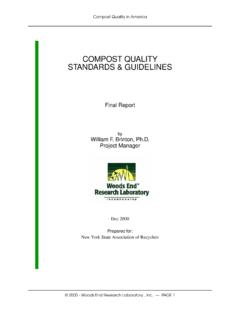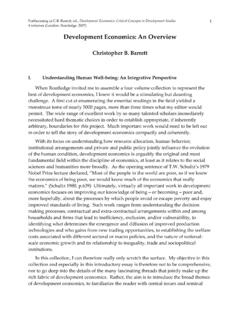Transcription of 3D Semantic Parsing of Large-Scale Indoor Spaces
1 3D Semantic Parsing of Large-Scale Indoor SpacesIro Armeni1 Ozan Sener1,2 Amir R. Zamir1 Helen Jiang1 Ioannis Brilakis3 Martin Fischer1 Silvio Savarese11 Stanford University2 Cornell University3 University of (a) Raw Point Cloud(b) Space Parsing andAlignment in Canonical 3D Space(c) Building Element DetectionEnclosed 1: Semantic Parsing of a Large-Scale point cloud. Left:the raw point :the results of Parsing the point cloud intodisjoint Spaces ( the floor plan).Right:the results of Parsing a detected room (marked with the black circle) into Semantic this paper, we propose a method for Semantic parsingof the 3D point cloud of an entire building using a hierar-chical approach: first, the raw data is parsed into seman-tically meaningful Spaces ( rooms, etc) that are alignedinto a canonical reference coordinate system.
2 Second, thespaces are parsed into their structural and building ele-ments ( walls, columns, etc). Performing these with astrong notion of global 3D space is the backbone of ourmethod. The alignment in the first step injects strong 3 Dpriors from the canonical coordinate system into the secondstep for discovering elements. This allows diverse challeng-ing scenarios as man-made Indoor Spaces often show recur-rent regularities while the appearance features can changedrastically. We also argue that identification of structuralelements in Indoor Spaces is essentially a detection prob-lem, rather than segmentation which is commonly used. Weevaluated our method on a new dataset of several buildingswith a covered area of over6,000m2and over215millionpoints, demonstrating robust results readily useful for prac-tical IntroductionDuring the past few years, 3D imaging technology ex-perienced a major progress with the production of inexpen-sive depth sensors ( Kinect [2]).
3 This caused a leap inthe development of many successful Semantic segmentationmethods that use both RGB and depth [27, 32, 8]. How-ever, the 3D sensing field has recently undergone a follow-up shift with the availability of mature technology for scan-ning Large-Scale Spaces , an entire building. Such sys-tems can reliably form the 3D point cloud of thousands ofsquare meters with the number of points often exceedinghundreds of millions (see Fig. 1 left). This demands seman-tic Parsing methods capable of coping with this scale , andideally, exploiting the unique characteristics of such scans of buildings pose new chal-lenges/opportunities in Semantic Parsing that are differentfrom, or not faced in, small- scale RGB-D segmentation:Richer Geometric Information: Large-Scale point cloudsmake the entire building available at once.
4 This allowsutilizing recurrent geometric regularities common in man-made possibilities are beyond what asingle-view depth sensor would provide, as they have partof one room or at most few rooms in their : Existing Semantic segmentation methods de-signed for small- scale point clouds or RGB-D images arenot immediately applicable to Large-Scale scans due to com-plexity issues and the fact that choosing a set of represen-tative views from an unbounded number of feasible single-views is of New semantics : Large-Scale point cloudsof Indoor Spaces introduce semantics that did not exist insmall- scale point clouds or RGB-D images: disjoint spaceslike rooms, hallways, etc. Parsing a raw point cloud intosuch Spaces (essentially a floor plan) is a relatively new andvalid Applications: A number of novel applications be-comes feasible in the context of whole building pointclouds, such as, generating space statistics, building analy-sis ( , workspace efficiency), or space manipulation ( ,removing walls between rooms).
5 Aforementioned points signify the necessity of adopt-ing new approaches to Semantic Parsing of Large-Scale pointclouds. In this paper, we introduce a method that, given araw Large-Scale colored point cloud of an Indoor space, firstparses it into Semantic Spaces ( , hallways, rooms), andthen, further parses those Spaces into their structural ( , walls, etc.) and building ( furniture) elements (seeFig. 1). One property of our approach is utilizing in seman-tic element detection the geometric priors acquired fromparsing into disjoint Spaces , and then, reincorporating thedetected elements in updating the found Spaces (Sec. ).Another key property is reformulating the element pars-ing task as a detection problem, rather than segmentation paradigms start with the assumptionthat each point must belong to a single segment/class.
6 How-ever, the problem of building element Parsing better fits adetection approach. Clutter can occlude parts of importantelements, a white board can occlude a wall. To a seg-mentation technique, this wall would be an irregular entitywith a hole on it, while detecting the wall as a whole pro-vides a better structural understanding of it (see Sec. 4).The contributions of this paper can be summarized as:I)We claim and experimentally evaluate that space di-viders ( walls) can be robustly detected using the emptyspace attributed to them in the point cloud. In other words,instead of detecting points belonging to the boundaries of aroom, we detect the empty space bounded by )We show that structural and building elements can berobustly detected using strong geometric priors induced byspace Parsing . We demonstrate satisfactory Parsing resultsby heavily exploiting such )We collected a Large-Scale dataset composed of col-ored 3D scans1) of Indoor areas of large buildings with var-1 Collection of points with 3D coordinates and RGB color architectural styles.
7 A few samples of these Spaces canbe seen in Fig. 1 and 5. We annotated the Semantic spacesand their elements in 3D. We further collected a set of RGB-D images registered on the colored point cloud to enrich thedataset (not used by our method). Annotations are consis-tent across all modalities (3D point cloud and RGB, anddepth images). The dataset, annotations, the code and pars-ing results of the proposed framework are available to pub-lic at Related WorkWe provide an overview of the related literature below,but as a brief summary, the following main points differ-entiate our approach from existing techniques: 1) process-ing a Large-Scale point cloud of an entire building (indoorspaces), rather than one or few RGB-D images, 2) detectionof space dividers (walls) based on their void (empty) spacerather than planar-surface/linear-boundary assumptions, 3)utilizing a set of geometric priors extracted in a normalizedcanonical space, 4) adopting a detection-based approach,rather than segmentation, to element RGB-D and 3D segmentation have been in-vestigated in a large number of papers during the past fewyears.
8 For instance, [31, 25] proposed an RGB-D segmen-tation method using a set of heuristics for leveraging 3 Dgeometric priors. [22] developed a search-classify basedmethod for segmentation and modeling of Indoor are different from our method as they address theproblem in a small- scale . A few methods attempted usingmultiple depth views [30, 15], yet they as well remain lim-ited to a small- scale and do not utilize the advantages ofa larger scope. [23] performed Semantic Parsing of build-ings but for outdoor Spaces . To parse a panoramic RGB-D image, [42] uses the global geometry of the room andcuboid like objects. Though an RGB-D panorama includesmore information than a typical RGB-D image, it is notas comprehensive as a 3D point cloud. There also ex-ist many object detection methods developed for methods either try to extend the RGB methods di-rectly into RGB-D by treating depth as a fourth channel[14, 20, 32, 27, 3] or use external sources like CAD models[33].
9 These methods use image-specific features and do notextend to point clouds. They are also not designed to handlelarge structural elements, such as floor and the context of floor plan estimation, [4] proposed anapproach based on trajectory crowd sourcing for estimatinga floor plan, while we use an automatically generated 3 Dpoint cloud. [39] reconstructed museum type Spaces basedon Hough transform which is challenged in cluttered scenes(as verified by our experiments), though their goal is not es-timation of floor plan. [41] also employs similar planar sur-face assumption in order to estimate the semantics of a sin-gle room using contextual information. [21] HistogramConvolved Signal PeaksMaximum Peaksa. Input Signalxyb. Convolution with Filter Bank 12 10 8 6 4 202050100150200250300350 MaxPool d. Final Space Dividersc.
10 Max PoolingNMS 12 10 8 6 4 202050100150200250300350 12 10 8 6 4 202050100150200250c c1/2cwFigure :Convolution of the devised filter with the histogram signal. The Histogram signal along axisxis the histogram ofxcoordinates of all :Space divider detection algorithm. We start with the density histogram signal (a), convolve it with thefilter bank (b), and perform max-pooling (c) to identify the space dividers (d).cluttered Indoor Spaces but their method as well as that of[24] require prior knowledge of scan locations and extrac-tion of planar patches as candidate walls. [37] generateda minimalistic floor plan by first triangulating the 2D floorplan and then merging adjacent segments to obtain the finalspace partitioning. Their approach does not handle occlu-sions effectively and requires the scan locations.









